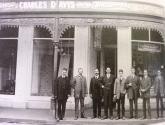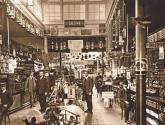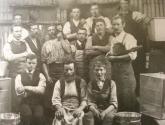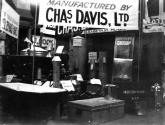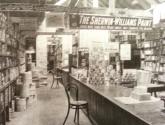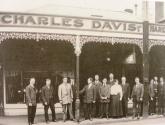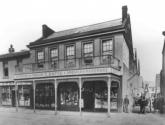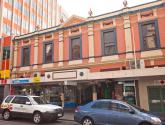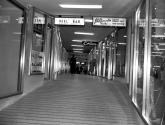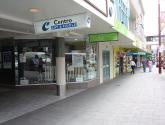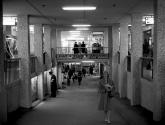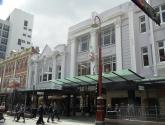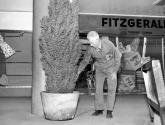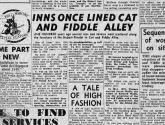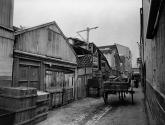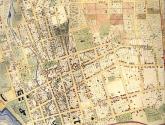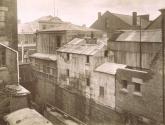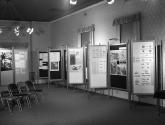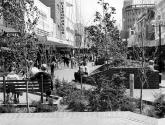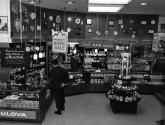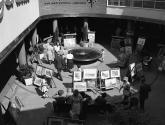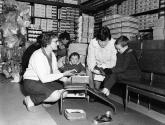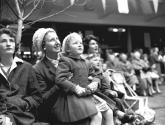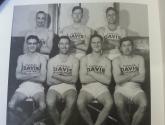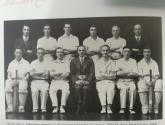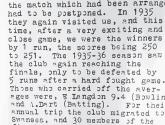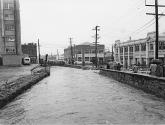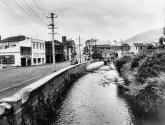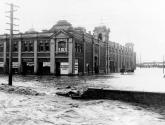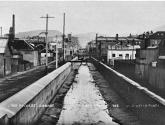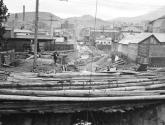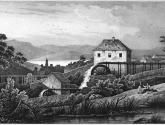The Charles Davis Company LTD
Charles Davis established the business in 1847. It grew into one of Tasmania’s major business enterprises specialising in hardware materials. It stayed in the control of the Davis family until it was taken over in 1971 by Sir Donald Trescowthick. Under his management the company embarked on significant expansion and diversification. At various times the company had investments in wholesaling, retailing, car distribution, property, hotels, motels and mining.
At its peak the company was Australia’s fourth largest retailer. The original shop closed in 1984 under the name of Charles Davis Ltd. The company was renamed as Harris Scarfe Holdings Limited in 1995.
CAT AND FIDDLE STORY
In 1958 Hobart architects, Philp Leighton Floyd & Beattie were engaged to plan the new arcade. Intense negotiation ensued to facilitate amalgamation of the site and long-term agreements had to be settled to provide for openings in common walls to give maximum traffic flow between all the stores which were to surround the arcade. The arcade was opened in July 1962 by the then Lord Mayor of Hobart, Alderman Basil Osborne.
THE CAT AND FIDDLE CLOCK
Modern electronics and an old English melody bring this nursery rhyme to life. Behind the stone façade of the mural wall is the “brain” that gives life to the rhyme, first published in 1765 by an unknown author.
A TUNE BY GLOCKENSPIEL
The melody played by a glockenspiel and vibraphone, was recorded in Melbourne and the musicians had to keep playing it again and again, until they took thirty seconds exactly – the time taken by the animated rhyme, with its cat, fiddle, dog, dish, spoon and cow to run its cycle. The clock strikes the hour and – hey, diddle, diddle – the children stand entranced as the cow jumps over the moon. It happens every day at the Cat & Fiddle Square on the hour from 8 am to 11 pm 7 days a week. In sequence the cat plays his fiddle, the cow jumps over the moon, the little dog laughs and – well you know the rest.
CAT AND FIDDLE ALLEY
The alley can be traced back to 1817 during the reign of Governor Sorrell. An inn called the Cat & Fiddle did a roaring trade down this little side street. In 1862 Cat & Fiddle Alley (now renamed Elizabeth Lane) became the new address for Charles Davis & Semple General Merchants. The inn had long since ceased to operate. The alley once consisted of some 20 houses, stables and a fellmonger’s yards.
A early description of the ‘Alley” – “ In the past it had echoed the echoes of hard fisted whaling men of a dozen nationalities English solidarity stamped its cobblestones. It knew gentlemen of leisure and let’s admit it, ladies of pleasure. Its attraction was a low roofed ill lit tavern called the Cat and Fiddle”
The Albion Hotel side entrance was located in the lane way. The Albion Hotel in Elizabeth Street was the Terminus for Cooley’s Coaches 1825-1835
COLLINS AND MURRAY STREETS
FITZGERALD DEPARTMENT STORE
George Parker Fitzgerald founded G.P. Fitzgerald, a Tasmania-wide department store in the mid 1880’s. The company existed as G.P. Fitzgerald and Co. Ltd until 1918, but it was taken over in 1911 and became a part of Charles Davis Ltd, until the name was changed again in 1995 to Harris Scarfe Holdings. G.P. Fitzgerald was a founding Director of the famous Cascades Brewery in Hobart and was one of three office bearers. The Hon. G. P. Fitzgerald, as President, was responsible in 1909 for changing the name of Cascades Sports Club to the South Hobart Soccer Club. Fitzgerald was one of 3 new members appointed as a Salmon Commissioner whilst he was an M.H.A.
CHILDHOOD MEMORIES
From the time of the opening in 1962 to the present, the Cat and Fiddle Arcade has had a place in the memories of all Tasmanian children and those memories now span generations. In the early years the clock square was a meeting place and was utilised for many exhibitions and demonstrations and community events.
Work And Play
Charles Davis Company was a champion for supporting and encouraging sporting teams within the community and within his staff. In the 1930’s there was the Charles Davis – Basketball Team, Cricket Team & Football Team. Employee’s picnic days and sports carnivals were highlights on the workers’ calendar.
HOBART IN FLOOD
1929 and 1947
In June 1947 the southern half of Tasmania was affected by its largest floods on record. Although flooding at its peak between June 16 and 18 affected almost all rivers and streams across the island, in the rest of the state, the flooding did not approach the extent of the better-known 1929 floods. Floods on rivers such as the Derwent and Huon were the largest on record and caused considerable damage.
The year 1946 had been one of the wettest on record throughout Tasmania. Hobart’s annual rainfall of 1,004 millimetres (40 in) is the second highest in 130 years of record and featured two record wet months in March and August but the first few months of 1947 were relatively dry. However, an east coast cyclone on the 24th and 25th of May set in motion a sequence of low pressure systems that produced almost continuous rainfall over southern and western Tasmania that extended occasionally to the rest of the island, especially on the third and fourth of June when falls reached 70 millimetres (2.8 in) for two days in Hobart.
THE FLOOD OF 1960
Widespread and extreme flooding throughout the state also occurred in 1960. Hobart was impacted by the flood waters. Flooding was widespread. Raging flood waters from the uncontrollable Hobart Rivulet swept along the main thoroughfares and into scores of businesses. The centre of the city was in chaos. Much of Charles Davis Ltd.’s floors were covered in silt and many goods were washed away. The call was put out and many employees came in on the Sunday. After three days of hard work the store was ready to reopen on the Tuesday for a flood sale.
Hobart sustained record losses estimated at £3 million as the Hobart Rivulet flooded. Water ran knee-high in Liverpool Street, and the Army was called to help in the rescue. Flooding in the stream was always a problem. Early bridges were the first to suffer damage or destruction. The flood control measures constructed in the 1960’s have restricted the flow of water in some parts to almost a third of what it used to be. A raging rivulet is rarely seen now, except after heavy snow on the mountain.
A RUN OF CLEAR FRESH WATER
THE RIVULET – “BIRTHPLACE OF INDUSTRY”
When Hobart was founded in 1804, many of the early settlers erected their tents along the
section of Collins St, between Elizabeth and Murray Sts. February 21, 1804 Governor Collins spoke of his settlement as being situated ideally because it had a permanent supply of clear, running water. In 1815 with a government grant Arnold Fisk built the first mill with a second in 1818 built by the Government. In 1819 Fisk then built a third mill on the section of land known as Lower Mill on the banks of the rivulet between, Murray & Elizabeth Streets. Besides these mills, the rivulet provided power for timber mills and water for breweries. Much of the early wealth in Tasmania came from the industries built on the banks of the rivulet.
The course of the stream was subject to a number of diversions as the township grew. Minor changes resulted from land reclamation, water supply dams, minor flood controls and mill races. But the first major diversion was the ‘New Cut’, begun in 1824. It ran parallel to Collins Street to join the Park Street Rivulet rather than across the original ‘natural’ bed of the Rivulet (under the present City Hall and then into the Derwent near the site of the present Zero Davey building). The original stream bed east of Collins Street was filled in to form the new Market Place in 1825-26.
In 1882 the flow of water and detritus was contained in a canal with timber retaining walls which ran along the line of what is now Evans Street. Then in 1914-16 the stream was diverted through a major culvert and tunnel under the Queens Domain to reach the River Derwent north of Macquarie Point. The canal was then filled in and became Evans Street
The rivulet became an important part of the town. Gigs from the ships in port rowed up the stream and sailors went ashore at any one of the many bridges. Hotels grew up on the banks, one of the more notorious being the Terminus Inn, more commonly known as the “Do Drop Inn”.
